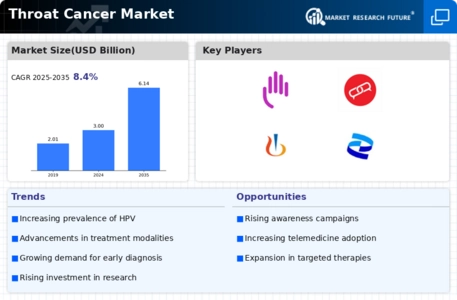Market Share
Throat Cancer Market Share Analysis
To succeed in throat cancer treatment, market share positioning must be nuanced. Companies in this sector focus on understanding throat malignancies, developing new treatments, and using targeted marketing to reach patients and medical professionals. Understanding throat cancers is essential for success. The firms invest much in research to establish the molecular characteristics, staging, and prognosis of throat cancer subtypes. This lets firms provide customized treatments. Differentiation via innovation is key. Drug firms are developing targeted, immunotherapies, and precision medicine to enhance throat cancer therapy effectiveness, side effects, and outcomes. Establishing medical professional ties is vital. Businesses provide training events and work with oncologists, otolaryngologists, and other professionals to enhance throat cancer treatment knowledge. This builds medical professional trust. Effective marketing requires customized communication. Businesses promote their throat cancer therapy' benefits, methods, and outcomes to attract clients. This ensures that patients and healthcare professionals get relevant and entertaining information. Due of their complexity, throat cancers necessitate global perspectives. Businesses engage in global clinical trials and partner with research institutions to gather data, speed regulatory clearances, and expand throat cancer treatment options. Effective regulatory mechanisms need skill. Companies prioritize strict regulatory compliance and expedited treatment approvals to guarantee patients have timely access to throat cancer therapies and earn a competitive advantage. Staying ahead of scientific advances requires strong collaboration with research institutions. To benefit on academic institutions' expertise, companies form strategic partnerships, which leads to breakthrough throat cancer treatments. Affordable pricing is crucial. Companies typically provide patient assistance programs to help throat cancer sufferers follow their treatment plans. These initiatives assist firms create profitable, accessible pricing schemes. Digital media is essential for patient outreach. Companies raise throat cancer awareness via social media, forums, and seminars. They provide patients and families with information, resources, and support. Examination of real-world data drives continuous development. After launching their throat cancer therapies, firms closely evaluate their performance and results and utilize input to enhance their processes and patient outcomes. Training programs for healthcare personnel are essential. Companies invest in oncologists' expertise and experience to ensure effective throat cancer diagnosis, prescription, and administration. Optimized supply chains are essential for market share positioning. Businesses are reducing their operations to ensure a consistent supply of throat cancer medicines to healthcare facilities worldwide. Compassion and clever thinking may be shown via patient support and advocacy campaigns. Companies' activities to build brand loyalty and help throat cancer patients may provide emotional support, resources, and community. Research and development must be prioritized. Leading firms are researching innovative therapeutic methods, biomarkers, and combination medicines to stay ahead in throat cancer treatment.







Leave a Comment